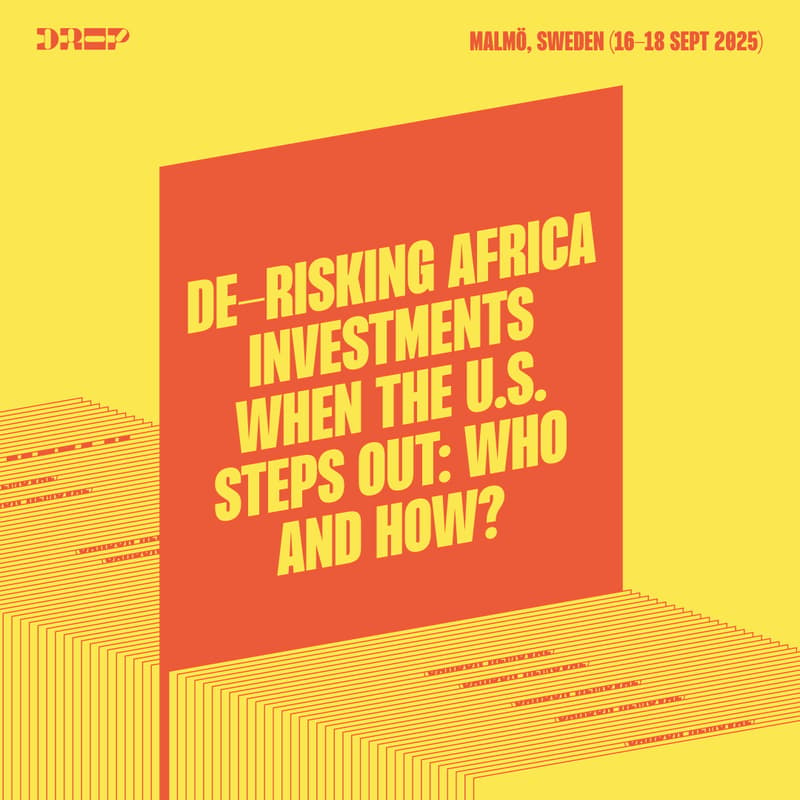

De-risking Africa investments when the U.S. steps out: who and how?
Ripple Hosts
Marianne Smallwood
Former USAID
Desiree Pettersson
Satgana
TL;DR
When the world’s biggest bilateral donor- and a major de-risker of investments in Africa- steps back from the world stage, how can VCs, remaining donors, and philanthropic funders align to ensure capital still moves towards Africa-based investments? As the climate reality is once again politicized, how can different investors turn scarcity into opportunity?
Topic overview
Why is the topic relevant?
On January 20, the Trump administration imposed a 90-day suspension on all foreign aid, halting all financial support distributed by the United States Agency for International Development (USAID). On March 10, the administration then announced the closing of USAID, eliminating almost 90% of the organization’s global funding. This decision has already had profound and far-reaching effects on spurring economic growth, advancing climate goals, improving healthcare, and delivering food assistance, triggering widespread concern in emerging markets- none more so than Africa.
For context:
In 2023 alone, USAID allocated a total of $12.1 billion to development programs across Sub-Saharan Africa.
In 2024, the United States accounted for around 8 out of every 100 dollars contributed by wealthy nations to developing countries to help reduce greenhouse gas emissions and aid climate adaptation.
In 2025, up to $11 billion in climate finance will be missing, the very year when scaling up public climate finance was meant to be prioritized. A third of this funding was intended to flow through USAID.
The shift in U.S. foreign policy has caused distress across the African continent, leaving hundreds of thousands of people out of jobs and millions without critical support provided by USAID funding. Some research suggests that the short-term impact of these cuts could push more than 5.7 million Africans into extreme poverty as early as next year.
Although improvements to aid allocation were necessary - as is the case in any large organization or company - the abrupt cutoff without a transitional period for governments, donors, and other funders, has left investors scrambling to reallocate resources and reconsider their funding strategies. At the same time, startups are struggling to fill the gap left by the loss of risk-tolerant capital that supports their growth before traditional VC and LP investments becomes available.
However, with every moment of crisis, there is also ample opportunity. As the U.S. government steps out of Africa and the climate space, it leaves a robust pipeline primed for investment, a blueprint for operating, and lessons learned so those remaining in the climate space can move forward without repeating the same mistakes. Subsequently, a number of valuable questions are being raised: while investing with an expectation of returns fosters independence and accountability, what realistic returns can investors expect in emerging markets such as Africa, given the competition for capital against less risky markets abroad? Who are the lead investors that will navigate the risk-return trade-off? What role do donor-funded programs play in mitigating risk for emerging markets investment in an environment that is shifting away from aid and more towards investment and trade?
Sub-Saharan African countries need partners, not patrons giving handouts. Yet the transition away from foreign donor dollars must be navigated with care to ensure social, environmental, and economic progress is not reversed while a new- and hopefully more sustainable- development order is taking shape.
What’s up for discussion?
Top five questions:
The U.S. government is again politicizing the “C” word and withdrawing its funding for climate and its largest philanthropies are more cautious about climate and the Global South. How can VCs, donors, and other investors continue to invest in and de-risk investments in regions of opportunity like Africa?
How are VC investors in Africa perceiving the impact of donor capital withdrawal on the market and their investments?
How can philanthropic, concessional, and commercial capital sources collaborate to create a capital stack that is suited to the state and needs of the African market while avoiding long-term dependency issues?
How can we better use philanthropic funding alongside VCs to better support startup growth, especially in more difficult markets like sub-Saharan Africa?
Which U.S. and European investors still have the appetite to invest in Africa despite scarcer donor funding? How do we make the case for why Africa in this environment?
Other questions (if needed):
How can we navigate and advocate for maintained or increased investments in climate, and with whom?
Who can take the place of the U.S. government and USAID in terms of donor funding for climate?
Which LPs are leading and why, and what practical examples can we take from them?
Dream outcome
Meeting great LPs that are excited to build a profitable and impact-based model that pairs philanthropic capital alongside VC funding for climate-oriented startups in sub-Saharan Africa.
Meeting investors keen on achieving great returns in markets perceived to be too risky.
Convincing U.S. investors that climate investments and Africa is absolutely worth investing in and an opportunity they cannot sleep on.
Who should attend?
Any VC, investors (particularly family offices, HNWIs, and foundations), and donors who invest in climate, Africa, and ideally climate AND Africa.